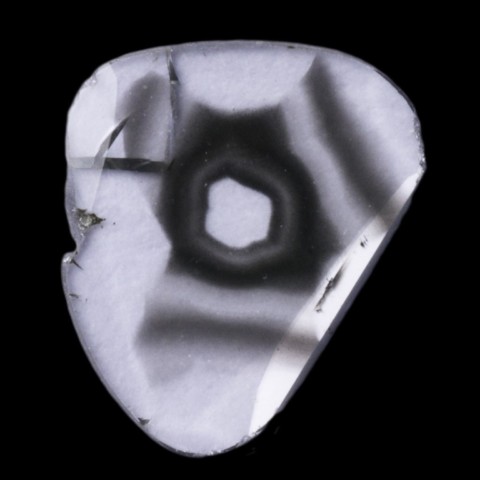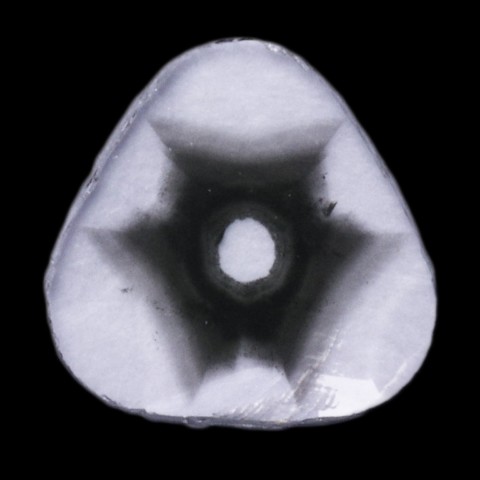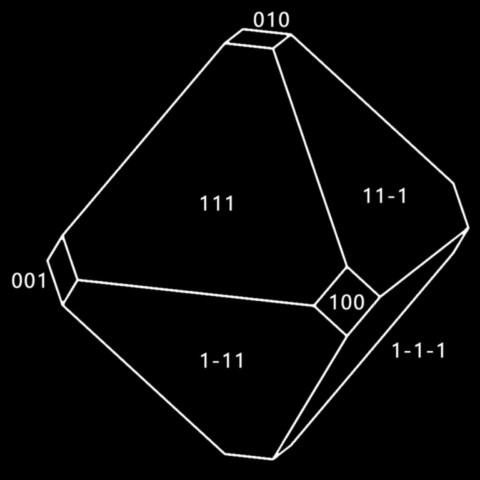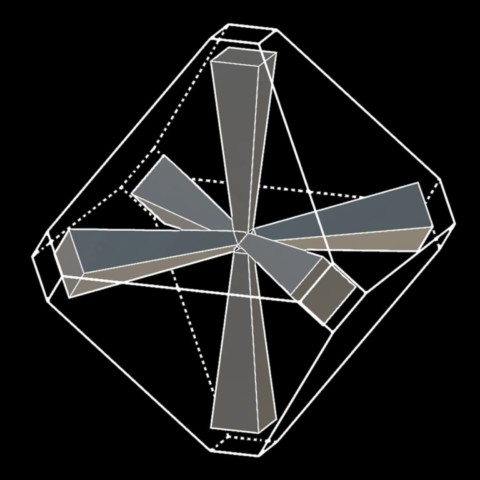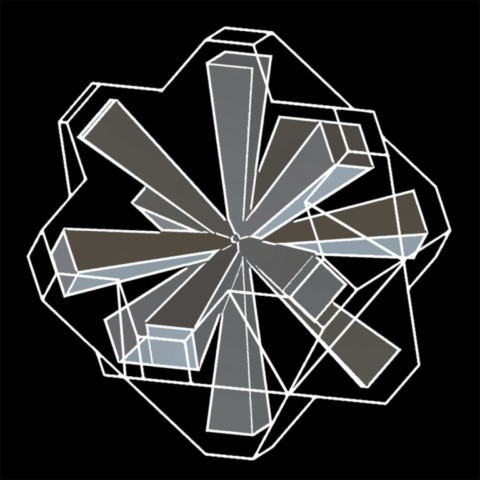"Trapiche-like" diamonds from Zimbabwe
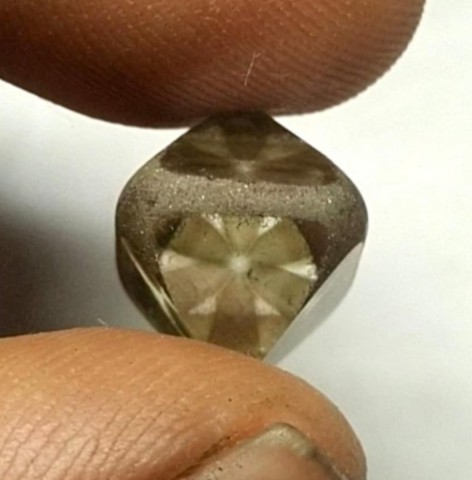
Zoned diamonds, sometimes incorrectly called "trapiche" because of their star-shaped patterns (with 2, 3, 4 or 6 branches), come from Zimbabwe. They have distinct zoning according to the orientation produced during crystal growth. This phenomenon, observed in rough diamonds or polished slabs, is due to chemical, structural or physical variability between sectors of the crystal (Rakovan, 2009). These diamonds, generally semi-transparent or opaque, have stood out as collector's items and in fine jewelry since their emergence at the Tucson show in 2010. Some can be impressive with their dimensions of almost 2 cm for several dozen carats...
Photo de droite : Trapiche-like diamond from Zimbabwe in octahedra with polished faces of 17.89 ct for a dimension of approximately 1.5 cm.
Invisible chemical zoning
Elements such as nitrogen, hydrogen, boron, silicon, cobalt and nickel can substitute for carbon in the diamond crystal lattice. Studies show a chemical zoning of these elements, for example nickel is more concentrated in the octahedral sectors (Meng et al., 2003) as is nitrogen. These chemical zonings are usually not visible, they can only be detected by laboratory analyses. They can be observed for example by cathodoluminescence using a SEM (emission of light by the diamond subjected to electron bombardment). The cubic sectors of these diamonds often show a green luminescence, while the octahedral sectors show a weak blue luminescence.
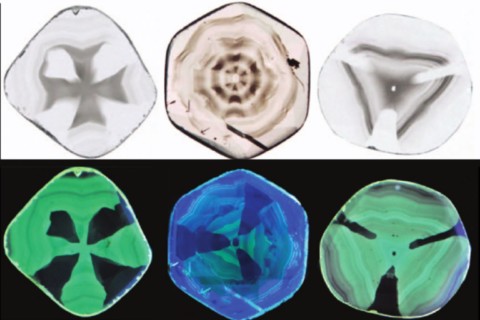
Zimbabwe diamond slices in cathodoluminescence after John Rakovan and Eloïse Gaillou (2014)
Gray-black zoning
In diamond slices, cubic {100} sectors are optically differentiated from octahedral {111} sectors by a gray to black color that also highlights the concentric zones. The gray color associated with cubic sectors is due to a very dense accumulation of light-scattering inclusions. These inclusions were analyzed by Raman spectroscopy by Rakovan et al. (2014), and were found to be graphite inclusions. Howell, Griffin, Piazolo et al. (2013) showed that the inclusions are in fact defects known as "disk-crack-like defects", they form at the interface of cubic and octahedral sectors due to the different growth mechanisms of these crystallographic faces or to differences in crystal strains. These defects are then covered by graphite during diamond growth.
Crystal shapes and zoning patterns
Two series of faces develop on Zimbabwe diamond crystals : the faces of the cube (100) and the faces of the octahedron (111).
The faces of the cube {100} are 6 in number: (100), (001), (010), (00-1), (-100) and (0-10)
The faces of the octahedron are 8 in number: (111), (-111), (-1-11), (-1-1-1), (1-11), (1-1-1), (-11-1), (11-1)
Grey zoning is formed on the cubic sectors. Depending on the orientation and thickness of the polished slices made, star-shaped patterns with 2, 3, 4 and 6 branches are observed as shown in the diagrams below.
Twinning on diamond crystals are generally not rare, they would theoretically allow to have 10-branch patterns on sections parallel to the faces of the cube, hitherto not observed by us.
Origin of Zimbabwe’s Diamonds
Zone diamonds of this origin, although cut and faceted in India, are believed to have originated in Chiadzwa, in the Marange region of eastern Zimbabwe. The Marange diamond deposits, located in Manicaland province, represent one of the country’s largest sources of diamonds, covering a vast area of 66,640 hectares. These alluvial deposits, discovered by villagers in 2006, led to a diamond rush attracting thousands of artisanal miners and illegal traders. Initially exploited by companies such as Kimberlitic Searches (De Beers) and Africa Consolidated Resources (ACR), the deposits were nationalised after these companies failed to deliver, partly due to the country’s risky economic and political conditions.
The discovery sparked massive informal exploitation, with nearly 35,000 illegal artisanal miners and 5,000 foreign traders in 2008. These activities attracted international attention, including accusations of human rights abuses and forced evictions aimed at regulating the disorderly rush. As a result, the Kimberley Process, an international system aimed at preventing the trade in “conflict diamonds,” imposed strict monitoring of diamonds from Marange. The government eventually tightened controls on mining through the Minerals Marketing Corporation of Zimbabwe (MMCZ), which was tasked with overseeing the marketing of diamonds. However, because the MMCZ offered uncompetitive purchase prices, many miners continued to turn to the black market, fueling the illegal trade.
In addition to these ethical challenges, Marange diamonds, with an estimated value of $800 billion and a projected mining life of 30 years, could potentially contribute up to 25% of global diamond demand. Zimbabwe currently ranks seventh in the world in terms of production, with significant growth prospects if more stringent and transparent regulatory policies are put in place to channel this wealth into sustainable development.

Map of the Marange diamond deposit, Zimbabwe from Gumbo T. (2013)
References :
Rakovan et al. (2014). Optically Sector-Zoned (Star) Diamonds from Zimbabwe, Rocks & Minerals, 99, 173-178
Howell D., Griffin W.L., Piazolo S. et al. (2013). Sector-zoning and defects in cuboctahedral diamonds. Geochimica et Cosmochimica Acta.
Rakovan, J. (2009). Sector Zoning in Crystals: Implications for Mineral Chemistry and Physics. American Mineralogist.
Meng, Y., et al. (2003). Nickel Distribution in Synthetic Diamonds. Physics and Chemistry of Minerals.
Evans, T. (1979). Heating Events and Diamond Stability. Journal of Geophysical Research.
Walker, J. (1979). Cathodoluminescence in Diamond Studies. Nature.
Gumbo, Trynos. (2013). Public-Private Partnerships (PPPs) and Sustainable Natural Resources Exploitation in Africa: Lessons from Diamond Mining in Chiadzwa, Zimbabwe. 10.13140/2.1.3856.8647.
Human Rights Watch. (2009). Diamonds in the Rough: Human Rights Abuses in the Marange Diamond Fields of Zimbabwe. Human Rights Watch.
Chimonyo, R., & Mabiza, J. (2014). An Analysis of the Socioeconomic Impact of Diamond Mining in Marange, Zimbabwe. African Journal of Business Management.
Partnership Africa Canada. (2010). Diamonds and Clubs: The Militarized Control of Diamonds and Power in Zimbabwe.


